Augusta Confederate Monument (Richmond County Confederate Monument)
Introduction
Text-to-speech Audio
Images
Augusta Confederate Monument
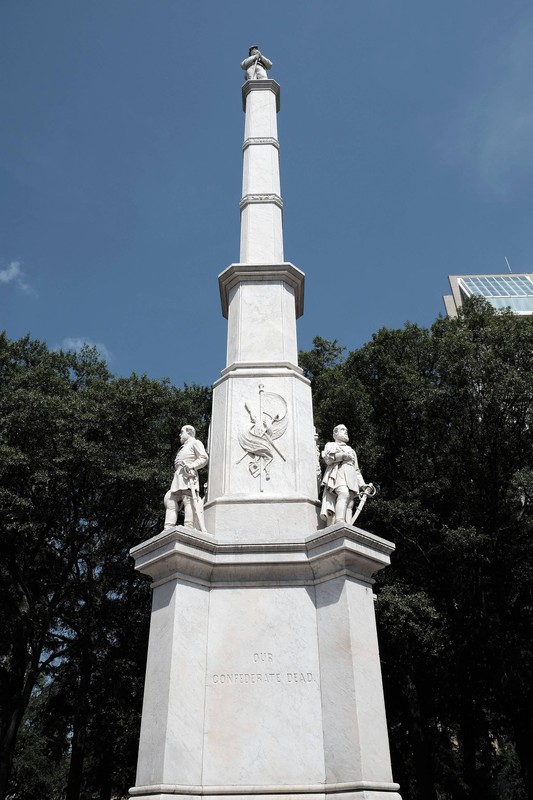
Augusta Confederate Monument, 1903
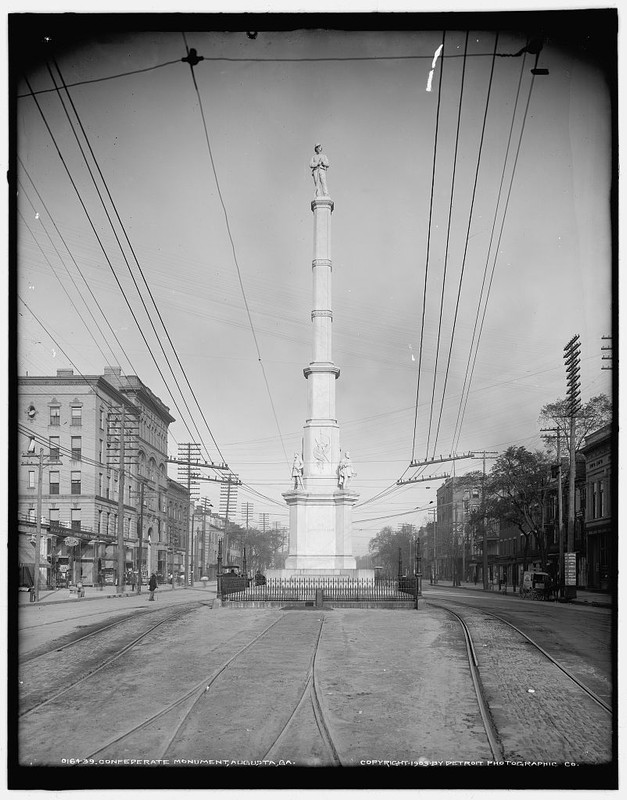
Augusta Confederate Monument
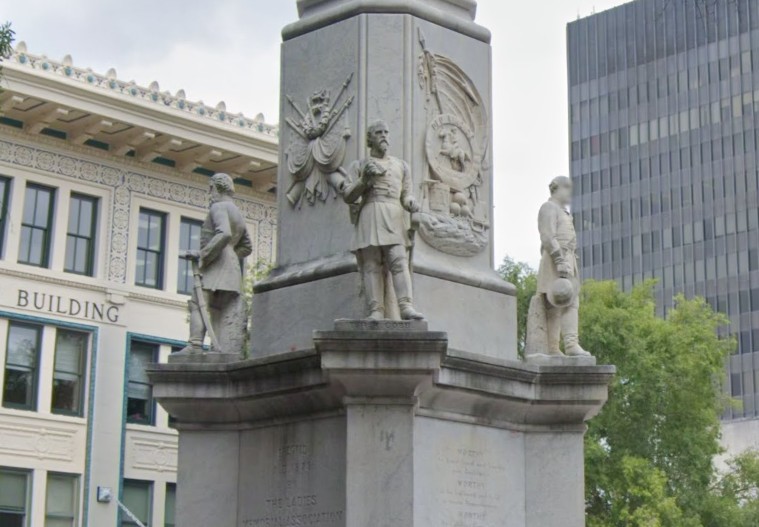
Augusta Confederate Monument
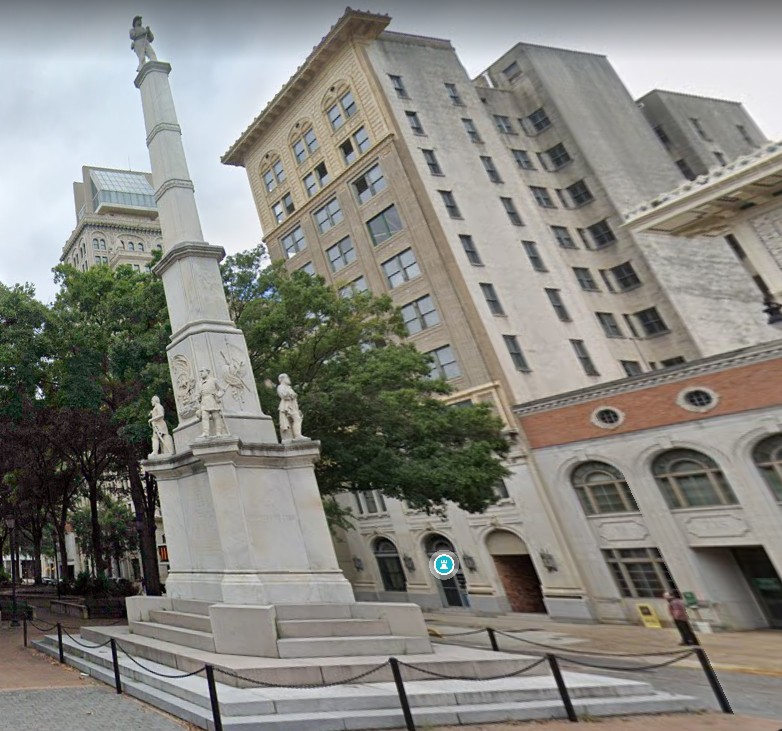
Augusta Confederate Monument
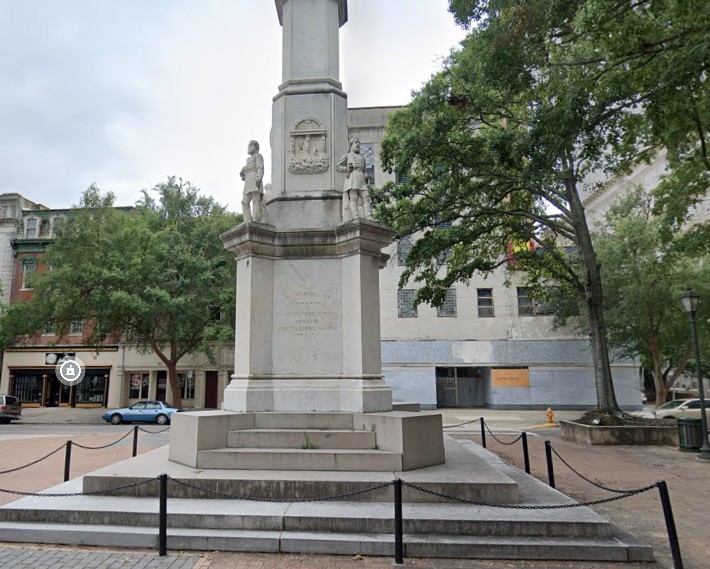
Augusta Confederate Monument
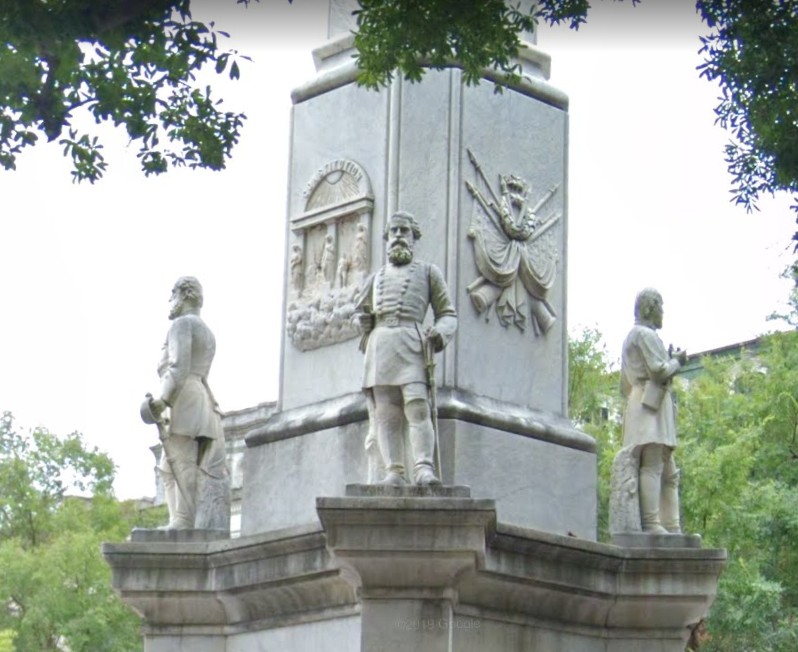
Depiction of Berry Benson as the "anonymous soldier" on top of the Augusta Confederate Monument
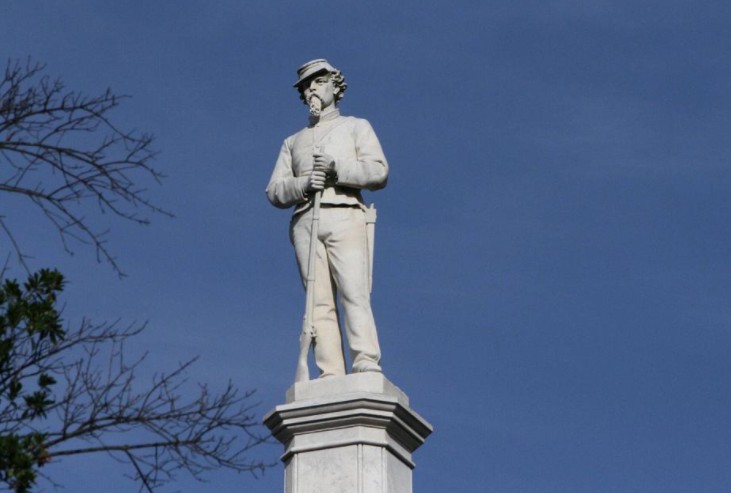
Postcard of the Augusta Confederate Monument, sometime after 1898.
.tiff.jpg)
Confederate Berry Benson (from The Photographic History of the Civil War, Francis Miller, 1911)
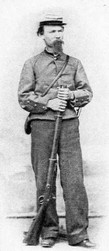
Berry Benson later in life
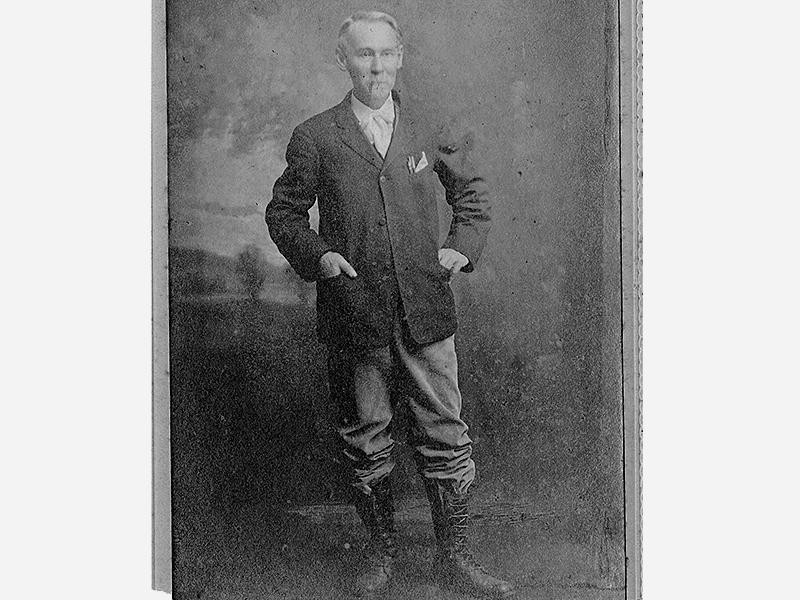
Berry Benson leading a 1917 review before Woodrow Wilson carrying his Civil War rifle
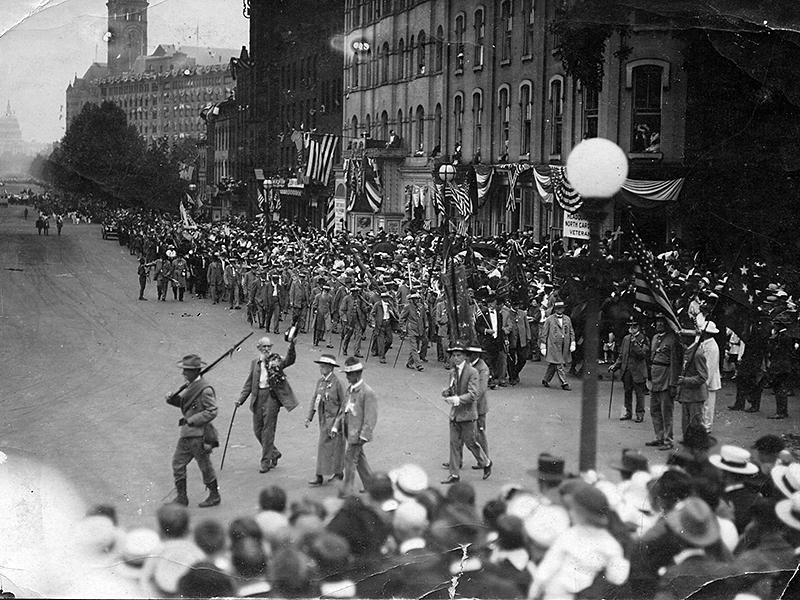
Anti-removal rally at the Augusta Confederate Monument on August 16, 2020
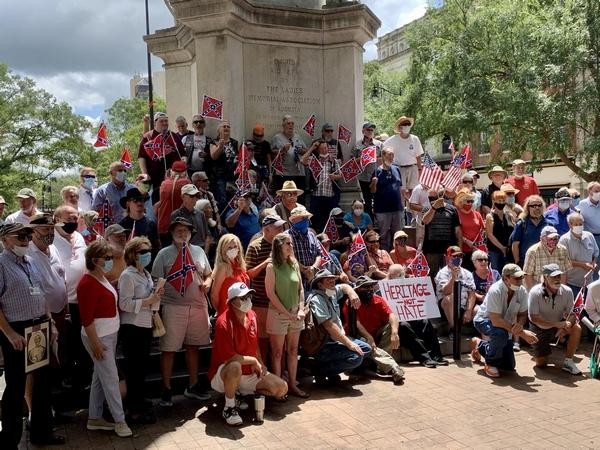
Que McQueen protests for the Confederate monument's removal
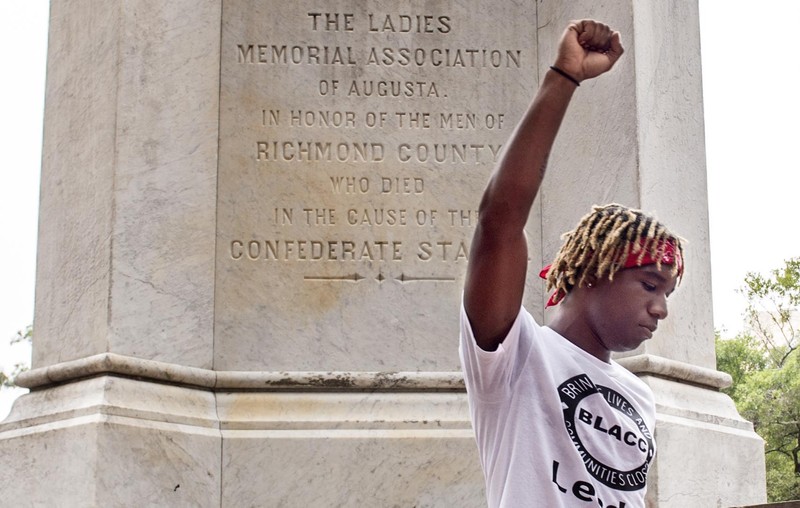
Backstory and Context
Text-to-speech Audio
The Augusta Confederate Monument (occasionally referred to as the Richmond County Confederate Monument) was the result of efforts by the local Ladies Memorial Association of Augusta. Such associations emerged almost immediately after the end of the Civil War, and as their name suggests, they worked to memorialize the Confederacy and its veterans in various ways: the establishment of Confederate cemeteries, celebrations of Memorial Days, and the erection of early Confederate monuments. In the 1890s, the United Daughters of the Confederacy (UDC) would assume many of the activities within a wider national organization.
In Augusta, the Ladies Memorial Association raised nearly $21,000 dollars to erect a monument to local Confederate veterans. Constructed of Italian marble and built by a local Augusta firm, the monument consists of a 4 foot tall granite base with four Confederate generals at the corners, a 72 foot tall marble shaft, and a marble Confederate private standing vigil atop. It was one of approximately 25 Confederate monuments erected in Georgia during the late 19th-century, with over 60 more monuments built in the early 20th century.
The Augusta Ladies Memorial Association organized in 1868 out of the Ladies Relief and Hospital Association and their first project was taking care of the graces of 337 soldiers. When they reorganized in 1872 the LMA turned their attention to erecting a Confederate monument in Augusta. The 1872 constitution of the Augusta LMA stated their goal of “the erection of a suitable Monument in the cemetery of the city of Augusta, in Memory of the noble men who laid down their lives in defence of Constitution of Liberty; whether they fell in battle or died from disease and wherever buried; and the stranger dead who now sleep in our midst.” [12] The Ladies started planning for the monument in 1873, holding benefit concerts and Christmas fairs in 1873 and 1874 to raise money.
The Augusta Ladies Memorial Association purchased the design from VanGunder and Young (based in Philadelphia) for $500. The figures were carved from Carrara marble from Italy by Antonia Fontana. Sculptor F. Markwalter was paid $14,490 to complete the monument. [1] The LMA requested that the monument be complete by Memorial Day in 1878; however it was not done on time and was instead erected and dedicated that fall.
The Augusta Confederate Monument depicts five Confederate individuals. The marble statue atop the monument doe not depict a generic Confederate soldier but rather Private Barry Benson. Benson enlisted in the 1st South Carolina Infantry in 1861 and participated in many famous Civil War battles in the East, including the initial Rebel bombardment of Fort Sumter. A well-known local veteran, Benson served as the model for the Confederate private on the monument and was dubbed "the Man on the Monument" by locals. Four Confederate leaders rest on the corners of the monument's base: well known Generals Robert E. Lee and Thomas "Stonewall" Jackson, Georgian General Thomas R.R. Cobb, and Augusta native General William H.T. Walker. Of these four generals, only Robert E. Lee survived the war (who passed away in 1870).
The dedication for the Augusta Confederate Monument occurred on October 31, 1878. An "immense crowd" attended the dedication, including Georgia Governor Alfred Colquitt (a former Confederate general himself) and Mary Anna Jackson, Thomas "Stonewall" Jackson's widow.[5] The keynote speech was given by Charles C. Jones, Jr. A well educated lawyer prior to the Civil War, Jones served in the Confederate artillery, notably during the 1864 Siege of Savannah. He resumed his legal practice after the war, but he rose to prominence as one of Georgia's foremost historians.
Charles Jones, Jr.'s dedication speech embodies many aspects of Lost Cause ideology. Despite slavery's central role in prompting the Civil War, Jones make almost no reference to it, only mourning "established institutions has been ruthlessly overturned." Instead, Jones presented the Civil War as a Southern struggle for liberty and self-rule:
"In open day, and in the face of the world, we here protest that so far from being 'rebels against legitimate authority and traitors to their country,' our Confederate Dead were 'lovers of liberty, combatants for constitutional rights, and, as exemplars of heroic virtue, benefactors of their race. For the past we have no apologies to offer, no excuses to render, no regrets to utter, save that we failed in our high endeavor..."
Jones touched upon other key Lost Cause themes as well. He glorified the martial abilities of Confederate soldiers, comparing them favorably to ancient Spartans and Napoleon's armies. He lauded Confederate generalship, praising Lee as "the embodiment of all that was highest, truest, grandest, alike in the hour of triumph and in the day of defeat. Him do we proclaim our great Captain, our exemplar." He identified the enemy's numerical superiority as the cause of defeat. "We yielded in the end because we were overborne by superior numbers and weightier munitions." He praised the "noble women of our city to erect a monument in honor of the Lost Cause."[4] (You can read the Jones' full speech in the sources below).
Such Lost Cause beliefs were also reflected in the monument's inscription: "No nation rose so white and fair: none fell so pure of crime."[5] The line comes from an 1866 poem by Philip Stanley Worsley in honor of Robert E. Lee. As Dr. Anna Harris-Parker of Augusta University has noted, "I am inclined to think Worsley intended the lines to suggest pure and just intentions of Lee and the Confederate army,” she said. “In other words, it seems to suggest that they thought they were doing what was right. Of course, it is possible and perhaps very likely that, as is the case with most poems, ambiguity was also part of Worsley’s intent.”[5]
In recent years, the Augusta Confederate Monument and its Lost Cause history have come under scrutiny. Following the violent 2017 "Unite the Right" rally in Charlottesville, Virginia, the local Augusta NAACP and churches began calling for the monument's removal. There's been significant push-back against the possibility of the monument's removal, however. The local United Daughters of the Confederacy have voiced opposition to removal.
In August 2020, following nationwide protests against systemic racism and the removal of many Confederate monuments, Augusta Mayor Hardie Davis formed a task force to reexamine Confederate monuments and Confederate-named places locally. Protests both in support and in opposition of the monument's removal occurred. As local activist Que McQueen argued the city needs to act: "The city that’s showing people that hey, white supremacy is ok. Hey, racism is fine. Hey the confederacy was white and pure and free of crime. That’s not the message we need to send to our children."[10] Conversely, Bert Brown organized a rally in defense of the monument, where over 50 people toted Confederate flags. "I just see all of these monuments being taken down across the states," Brown stated, "they’re trying to rewrite history. They’re trying to take that history away."[2]
The ultimate fate of the monument has yet to be decided. The city's task force is expected to make recommendations later in 2020.
Monument Text:
Front inscription: “OUR/CONFEDERATE DEAD
North panel description: “IN MEMORIAM/"NO NATION ROSE SO WHITE/AND FAIR:/NONE FELL SO PURE OF CRIME”
South panel inscription: “WORTHY/to have lived and known/our Gratitude:/WORTHY/to be hallowed and held/in tender Remembrance:/WORTHY/the fadeless Fame which/CONFEDERATE SOLDIERS/WON./who gave themselves in life/and Death for us:/For the Honor of Georgia./For the Rights of the States./For the Liberties of the People./For the Sentiments of the South./For the Principals of the Union./as these were handed down to/them by the Fathers of/OUR COMMON COUNTRY.”
Rear inscription: “ERECTED/A.D.1878/BY/THE LADIES/MEMORIAL ASSOCIATION/OF AUGUSTA./IN HONOR OF THE MEN OF/RICHMOND COUNTY./WHO DIED/IN THE CAUSE OF THE/CONFEDERATE STATES”
Sources
1. "Richmond County Confederate Monument, (sculpture)." Smithsonian Institution Research Information System (SIRIS). Web. Accessed August 18, 2020. https://siris-artinventories.si.edu/ipac20/ipac.jsp?session=P59D77E014786.4198&profile=ariall&uri=full=3100001~!335465~!0&ri=2&menu=search&source=~!siartinventories
2. Miguel Legoas. "Rally shows support for Augusta Confederate monument." August 17, 2020. Augusta Chronicle. Web. Accessed August 18, 2020. https://www.augustachronicle.com/news/20200816/rally-shows-support-for-augusta-confederate-monument
3. David N. Wiggins. "Confederate Monuments." October 31, 2018. New Georgia Encyclopedia. Web. Accessed August 18, 2020. https://www.georgiaencyclopedia.org/articles/history-archaeology/confederate-monuments
4. "Oration Pronounced by Col. Charles C. Jones, Jr." October 31, 1878. Web. Digitized. Accessed August 18, 2020. https://babel.hathitrust.org/cgi/pt?id=loc.ark:/13960/t89g5xp8h&view=1up&seq=1
5. Nefeteria Brewster. "Public attitudes changing toward Augusta's Confederate monument." August 19, 2017. Augusta Chronicle. Web. Accessed August 18, 2020. https://www.augustachronicle.com/news/2017-08-19/public-attitudes-changing-toward-augusta-s-confederate-monument
6. William Harris Bragg. "Charles C. Jones, Jr. (1831-1893)." September 3, 2014. New Georgia Encyclopedia. Web. Accessed August 18, 2020. https://www.georgiaencyclopedia.org/articles/history-archaeology/charles-c-jones-jr-1831-1893
7. Caroline E. Janney. "Ladies' Memorial Associations." March 8, 2012. Encyclopedia of Virginia. Web. Accessed August 18, 2020. https://www.encyclopediavirginia.org/ladies_Memorial_Associations#start_entry
8. Edward J. Cashin. "Berry Benson (1843-1923)." February 7, 2006. New Georgia Encyclopedia. Web. Accessed August 18, 2020. https://www.georgiaencyclopedia.org/articles/history-archaeology/berry-benson-1843-1923
9. Caroline E. Janney. "The Lost Cause." July 27, 2016. Encyclopedia Virginia. Web. Accessed August 18, 2020. https://www.encyclopediavirginia.org/lost_cause_the
10. Kim Vickers. "Local organizations continue protests against confederate monument." August 8, 2020. ABC WJBF. Web. Accessed August 19, 2020. https://www.wjbf.com/top-stories/local-organizations-continue-protests-against-confederate-monument/
11. Jeremy Turnage. "Augusta mayor names members of Confederate monuments task force." August 7, 2020. WRDW/WAGT. Web. Accessed August 19, 2020. https://www.wrdw.com/2020/08/07/augusta-mayor-names-members-of-confederate-monuments-task-force/
12. Hinnant, Lindsay Ann. “Lest We Forget: Ladies’ Memorial Associations in Georgia and the Creation of the Lost Cause.” M.A. Thesis. Georgia State University. 2015. https://core.ac.uk/download/pdf/214048982.pdf.
Heidi Heilbrunn, Augusta Chronicle: https://www.augustachronicle.com/news/2017-08-19/public-attitudes-changing-toward-augusta-s-confederate-monument
Library of Congress, https://www.loc.gov/item/2016799622/
Google Maps. Accessed April 12, 2021.
Google Maps. Accessed April 12, 2021.
Google Maps. Accessed April 12, 2021.
Google Maps. Accessed April 12, 2021.
"Common soldier fixed on top of Confederate monument tells a different story." The Augusta Chronicle. August 26, 2017. Accessed April 12, 2021. https://www.augustachronicle.com/news/2017-08-26/common-soldier-fixed-top-confederate-monument-tells-different-story.
"Augusta Confederate Monument." Wikipedia. Accessed April 12, 2012. https://en.wikipedia.org/wiki/Augusta_Confederate_Monument.
"Berry Greenwood Benson." Find A Grave. Accessed April 12, 2021. https://www.findagrave.com/memorial/28856862/berry-greenwood-benson/photo.
"Berry Benson (1843-1923)" New Georgia Encyclopedia. February 7, 2006. Accessed April 12, 2021. https://www.georgiaencyclopedia.org/articles/history-archaeology/berry-benson-1843-1923.
"Berry Benson (1843-1923)" New Georgia Encyclopedia. February 7, 2006. Accessed April 12, 2021. https://www.georgiaencyclopedia.org/articles/history-archaeology/berry-benson-1843-1923.
Miguel Legoas, Augusta Chronicle: https://www.augustachronicle.com/news/20200816/rally-shows-support-for-augusta-confederate-monument
Michael Holahan, Augusta Chronicle: https://www.augustachronicle.com/news/20200808/rally-urges-removal-of-broad-street-confederate-monument
